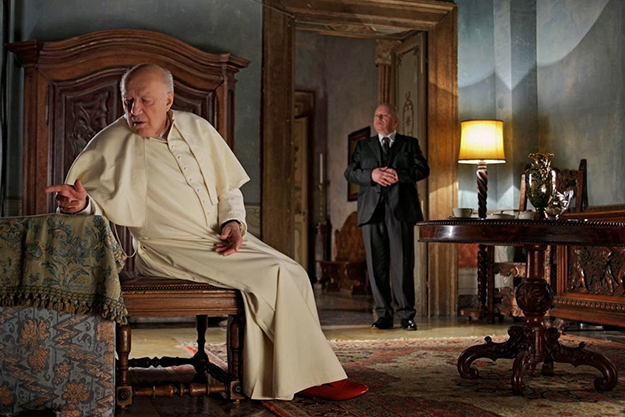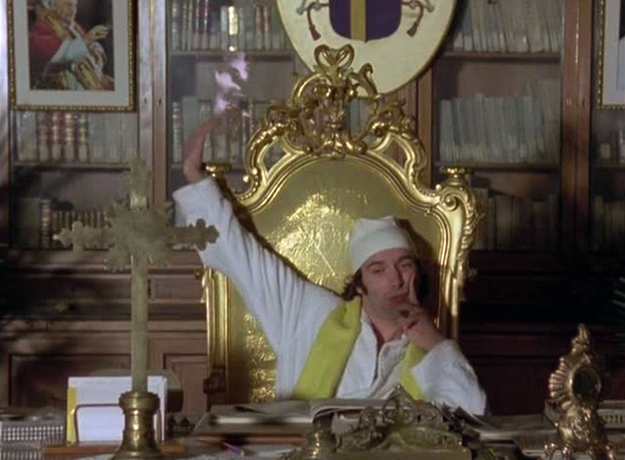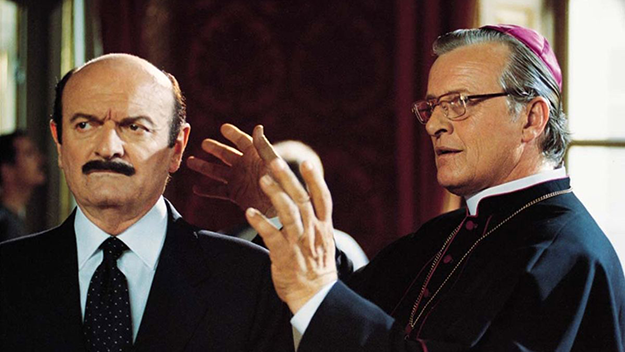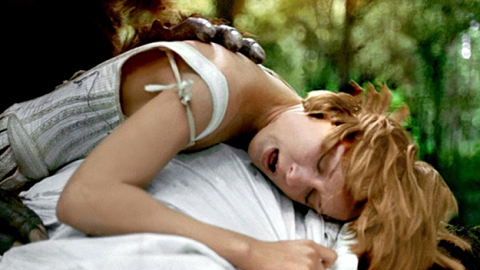Holy Seeing: The Vatican on Screen

Habemus Papam
When Otto Preminger was working on The Cardinal (1963), a film that touched upon interfaith marriage, racial bigotry, sex outside marriage, abortion and the rise of fascism among other issues, the production faced all sorts of pressures from the American Catholic Church. The film contentiously chronicled the rise to power of the titular cardinal and his personal dilemmas concerning the catholic church and faith. Shot in Boston and Rome, the Vatican liaison for the European shoot was a young German priest called Joseph Ratzinger who had served in the Luftwaffenhelfer during WWII and would eventually become Pope Benedict XVI. In 2013, for reasons that we will probably never know, Joseph Ratzinger became the first Pope to resign since Gregory XII in 1415. Only a year prior to his mysterious resignation, officially adduced to a “lack of strength of mind and body,” Nanni Moretti had presciently imagined the abdication of a reluctant Pope Elect played by Michel Piccoli in Habemus Papam. Moretti’s worldly Pope had more in common with the current, selfie-inclined Pontifex, than with the old-fashioned Ratzinger whose attempts to restore spiritual austerity and theological conservatism did not go that far.
But Ratzinger’s aborted mission was symbolically picked up by the fictional Pius XIII as played by Jude Law in The Young Pope, the TV series co-produced by Sky Italy, HBO and Canal+. Marketed as a sort of Vatican-set House of Cards, Paolo Sorrentino’s first foray into serial narrative fell short of Beau Willimon’s White House drama in very many respects. Painfully bereft of solid screenwriting, The Young Pope amounted to a disjointed, episodic carcass with no narrative backbone to keep it upright. It starts as Lanny Belardo (Jude Law), former Archbishop of New York becomes the ultra-conservative new Pope, sending shock-waves down the Vatican corridors for his refusal to appear publicly and engage with the media. Pius XIII is believed to be a saint by some, including Sister May (Diane Keaton), the nun who raised him, and mostly a bully by others. Be that as it may, the handsome leader has to deal with many problems not necessarily concerning divine questions, such as the struggle for power in a city-state where democratic transparency is the funniest joke in town. But the intrigue and diplomatic wars at the heights of the Vatican are in The Young Pope administrative disputes with no major consequences. Even by the deferential standards of Italian cinema when it comes to Vatican City, The Young Pope was rather docile.
The inner workings of the Vatican are inscrutable to say the least, and the repressive influence its theocracy exerts on Italian civil society is more rooted than it would superficially appear. Which is why among the most accurate and (sur)realistic films ever made about it must be counted Marco Ferreri’s L’Udienza (“Papal Audience,” 1972). Overtly inspired by Kafka’s The Castle, Ferreri’s film tells the story of Amedeo (played the great singer-songwriter Enzo Jannacci) and his obsessive quest to have a private meeting with the Pope. Father Amerin (Michel Piccoli, not yet head pontiff) is the only person in the entire film, spectators included, that gets to know the reason why Amedeo wants to meet the Pope when he whispers it in his ear moving him to tears. Despite Father Amerin’s intercession, the meeting with the Pope will never take place, as the stubborn protagonist is confronted by the impenetrable wall of bureaucracy surrounding Saint Peter’s square.

In the Pope’s Eye
A similar atmosphere of cryptic impenetrability permeates Damiano Damiani’s The Devil Is a Woman (1974) which explores the sway of religious institutions on the personal lives a group of willing inmates relegated to the convent-prison where the entire movie takes place. Another interesting example of anti-clerical cinema is Silvano Agosti’s In the Highest of Skies (1977) which features the curious disclaimer “The facts narrated in this film are fictional, the people who lived through them are not.” It’s set in Vatican City where a group of pilgrims gets stuck on an elevator that keeps on going up, refusing to stop. As the ride towards the sky proceeds apace, the pilgrims’ repressed urges are given free rein and the most unspeakable sins are committed before God’s fast-approaching eyes.
Filtered through the farcical if somewhat prophetic lenses of a musical comedy, the Vatican of In the Pope’s Eye (1980) prefigures a media-friendly Pope who, inspired by what he sees on television, decides to have his own Vatican broadcaster. The man tasked with the creation of the inaugural show for the new Vatican TV is the Italian showman Renzo Arbore playing himself (who also directed the film). He’s joined by a colorful crew of entertainers that includes Roberto Benigni and a very young Isabella Rossellini; the TV show they are working on is directed by Martin Scorsese (who has a small cameo). In the Pope’s Eye is an improv piece alternatively verging on the delirious and the blasphemous. In one memorable monologue, Benigni launches into an improbable marxist interpretation of Judgement Day and paints a clenched fist on Michelangelo’s God in the Sistine Chapel. Extremely popular at the box office (the sixth-highest-grossing film in 1980-81), the film was soon withdrawn from circulation and accused of “Contempt of State Religion.” Several bootlegged copies of the film circulated on VHS throughout the ’80s, granting Arbore’s film cult status until it was restored and re-released in the late ’90s.
Another film that didn’t go down well with the invisible censorship of the market was Peter Richardson’s The Pope Must Die(t) (1991). London Transport forbade to feature ads of the film on their buses and subways carriages while ABC, CBS, and NBC in America refused to run commercials on their networks. Richardson’s film follows the accidental misadventures of a low-ranking priest who is elected Pope by a spelling mistake, inadvertently taking the place of the Mafia-supported candidate which the conclave had nominated in cahoots with the mob. Initially determined to abdicate, the new Pope demands an investigation into the Vatican Bank after a journalist asks him to shed light on the corruption within the Catholic Church thus triggering the divine wrath of God’s bankers. Through the farcical tropes of an irreverent comedy Richardson dared to broach the ultimate Vatican taboo: its dark financial might. The Pope Must Die(t) didn’t even break even at the box office.

The Bankers of God: The Calvi Affair
As an official religious organization, the Catholic Church has been able to keep its financial dealings beyond legal scrutiny and to remain free from taxes. The Vatican’s official bank (IOR) is also shrouded in secrecy; even the new, progressive Pope Francis has left it untouched. Yet the scandals that have involved the IOR throughout the years are many, and a fairly major one was reconstructed by Giuseppe Ferrara in The Bankers of God: The Calvi Affair (2002), which fictionalized the bankruptcy of the Banco Ambrosiano bank and the mysterious death of its CEO Roberto Calvi. A member of the P2 Masonic Lodge, Calvi was found dead in 1982 under Blackfriars Bridge in London after the bank he presided over went bust following a bad loan granted under considerable pressure to the IOR, the Vatican’s bank. The related unsolved disappearance of Emanuela Orlandi was further investigated in last year’s The Truth Is in the Sky, directed by Roberto Faenza.
All of which suggests that there’s no shortage of juicy subject matter when it comes to the Vatican, and we’ll be seeing the St. Peter’s backdrop in movies for many popes to come.





